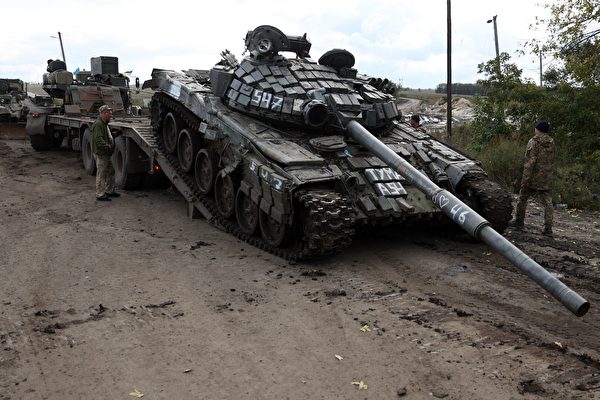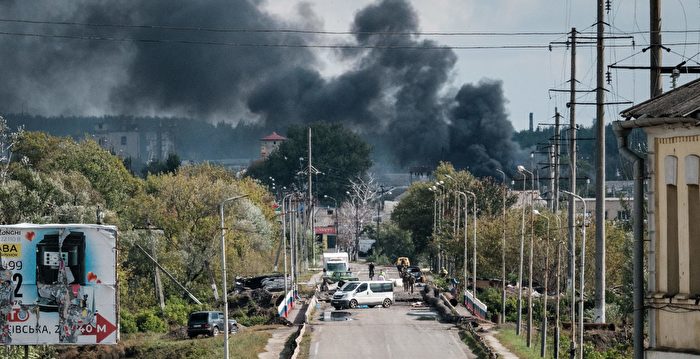[Epoch Times, September 26, 2022]The successful large-scale counterattack of the Ukrainian army in the northeastern region has impressed the outside world, and the strength of the Russian army has been re-examined. The U.S. Department of Defense revealed that there are currently about 100,000 Russian troops in Ukraine, roughly revealing the mystery of the Russian military’s inability to withstand the Ukrainian army’s counterattack. The U.S. Congressional Research Service recently released an assessment of the Russian-Ukrainian war, explaining why the Russian military could not achieve its goals.
How many casualties did the Russian army have?
The Russian army voluntarily abandoned the strategic fulcrum of Izyum in eastern Ukraine, reflecting the problem of insufficient Russian troops. The Kremlin issued a mobilization order to recruit 300,000 soldiers, sparking protests in Russia, and many men of school age began to flee Russia to avoid being caught.
On September 22, the US Department of Defense issued a press release, “Russian Mobilization May Be Reinforcing Failure in Ukraine” (Russian Mobilization May Be Reinforcing Failure in Ukraine). If Russia cannot command, maintain and equip its roughly 100,000 troops in Ukraine, adding another 300,000 troops will not improve the situation, the press release said.
The U.S. Department of Defense revealed that there are only about 100,000 Russian troops left in Ukraine, and it is really difficult to organize a large-scale offensive. Previously, the US Department of Defense had estimated that Russian casualties were between 70,000 and 80,000. Such a large loss means a serious loss of combat effectiveness. If the Russian army does not increase its troops in time, the war will be unsustainable.

On September 14, the Congressional Research Service released a report, “Russia’s War in Ukraine: Military and Intelligence Aspects.” The report analyzed the more than 200 days of the Russian-Ukrainian war and evaluated the performance of the Russian and Ukrainian armies.
The overall performance of the Russian army is poor
From the beginning of the invasion, the Russian military was hampered by specific tactical choices, poor logistical support, inefficient communications, and command and control problems, the report said. Momentum has turned in Ukraine’s favor after Ukrainian forces successfully recaptured territory in the northeast in September. The Russian military continues to suffer from structural deficiencies, and recent losses in personnel, equipment and morale may limit its combat capability.

According to the report, according to U.S. government estimates, before the invasion, the Russian army deployed a total of 150,000 to 190,000 people on the Ukrainian border, with 120 battalion-level tactical units; ground troops were equipped with artillery, rocket launchers, long-range precision missiles, air defense systems, and There are electronic warfare, support and logistics units; and a large number of fighter jets, fighter-bombers and helicopters.
The report believes that the Russian bombing failed to effectively suppress Ukraine’s air defense system, nor did it weaken the Ukrainian Air Force and Ukraine’s command and control capabilities. The Russian military has shown little tactical joint combat capability, and the level of training and professionalism appears to be far below expectations; Russian military units usually use civilian equipment to communicate in the absence of encrypted communications.
The report assesses that the Russian Air Force appears to have limited air cover for ground forces, relying mainly on Iskander missiles and cruise missiles fired from bombers in Belarus and Russia. The outside world has observed problems with the accuracy, capability and inventory of Russian missiles.
The report analyzes that each unit and propulsion axis of the Russian army is operating independently, and the degree of coordination is questionable. Russian commanders appeared unprepared for an invasion, communications problems exacerbated command and control problems, and senior officers moved closer to the front lines, resulting in numerous casualties. The logistical problems of the Russian army limited the offensive in almost all sectors.

How the Ukrainian Army Exploited the Weaknesses of the Russian Army
The report described that Ukrainian forces appear to be prioritizing ambush of Russian supply forces, exacerbating Russia’s logistical problems. The Russian military was overextended in many cases, enabling Ukrainian forces to ambush and counterattack.
The report argues that the resistance of the Ukrainian army, surprising and impressive, has proven resilient and adaptable, albeit at a disadvantage, which should benefit from high levels of motivation and recruitment, as well as significant Western security assistance and training.
The report analyzed that the Ukrainian army used space to attract the Russian army. With the advance of the Russian army, Ukraine adopted a guerrilla and ambush strategy, hit and ran, or attacked the Russian army supply line. Ukraine also uses drones and weapons aided by various countries to weaken the Russian military’s advantages. The Ukrainian military has adopted a decentralized command structure that allows each combat command to adapt and coordinate operations according to local conditions.

The battle lines go back to months ago
The report argues that Russia may have initially assumed that the Ukrainian army was lacking combat effectiveness and that political leadership could be easily replaced, miscalculated in part by insufficient intelligence and subordinates only sending positive messages to policymakers; a relatively small circle of advisers may have had a negative impact on Putin huge impact and contributed to unrealistic assumptions. It is believed that Russian Defense Minister Shoigu may have exaggerated the capabilities of the Russian military.
According to the report, the Russian army has made the greatest progress in the south, rapidly advancing to the Kherson area, because the Russian army has relatively better logistical support in the south because it is backed by Crimea. The Russian army’s offensive against major cities such as Kyiv and Kharkov has mostly stagnated. The Russian Air Force has increased the number of dispatches, but has begun to use unguided munitions. The most advanced helicopters, fighter jets and fighter-bombers suffered heavy losses.
The report analyzes that multiple fronts of the Russian military are competing for limited reinforcements, logistics and air support; ongoing logistical problems, increasing casualties, lack of available reinforcements, and Ukrainian counterattacks forced the Russian military to announce on March 25. Withdraw troops from around big cities like Kyiv and turn to eastern Ukraine. The Russian army seeks to surround and overwhelm the Ukrainian army in the east.
The report believes that the change in Russian strategy has limited the offensive from the south towards Odessa. On April 13, the flagship of the Russian Black Sea Fleet, the Moskva, was sunk by a Ukrainian Neptune anti-ship missile, sabotaging the Russian amphibious attack on Odessa and subsequently affecting control of Snake Island. The Ukrainian army used TB2 drones and fighter jets to attack the Russian army on the Snake Island, which was evacuated at the end of June.
According to the report, on April 18, the Russian army launched an offensive in the Donbas region of eastern Ukraine after a series of missile attacks, but in the face of resistance from the Ukrainian army, the Russian army was unable to make significant progress.
After the Ukrainian counter-offensive in early September, the Russian army quickly retreated, and the battle lines between the two sides have actually returned to a few months ago. The Russian army paid heavy casualties and occupied some territory in eastern Ukraine, but now Ukraine has regained more lost territory in the northeast.

The Russian army is understaffed and difficult to maintain
The report assesses that the fighting in eastern Ukraine over the past few months has been more like a slow and fierce traditional war, with the Russian army returning to its traditional reliance on the large-scale use of artillery and rocket launchers. Ukraine’s strategy is to reduce the number of Russian troops as much as possible. The war between the two sides gradually fell into a stalemate and a war of attrition.
The report described Ukrainian forces using drones and long-range weapons aided by the United States to undermine Russian control of the region. Before September 8, the Ukrainian army used Haimas rockets to carry out more than 400 attacks on high-value targets of the Russian army, attacking warehouses, command centers and infrastructure that could not be attacked before, resulting in serious logistical tensions for the Russian army. The Ukrainian army’s MiG-29 fighter jets carry anti-radiation missiles that constantly attack Russian radars or electronic warfare systems.
The report argues that Russia has expended a significant amount of its troops, and that it is difficult to make any significant territorial progress in the future, and appears to be focused on consolidating control of existing territories. The morale of the Russian army is low, and more and more soldiers refuse to fight or refuse orders from their superiors.
The report analyzed that the Ukrainian army’s offensive in Kherson distracted the Russian army, but it was not just a feint. The Russian army transferred the most combat-effective troops to the south to support the Kherson area. There were obvious intelligence and command errors and failed to detect the accumulation of Ukrainian troops in the northeast. Most of the Russian troops defending in northern Ukraine were troops who had not received front-line combat training. The Ukrainian army took advantage of the weak links of the Russian defense. Tanks led the high-mobility troops to quickly advance behind the Russian defense line, ambushing and cutting off the Russian army. reinforcements.
The report assesses that the Russian army does not appear to be able to coordinate effective resistance or re-establish defense lines; on September 10, the Russian army announced its withdrawal from Izum, almost a symbolic statement after the complete collapse of the region, and the Russian army also withdrawn from Ossum. All troops west of the Oskil river.

Change of command of the Russian army
According to the report, in April, General Dvornikov, the head of the southern military district of the Russian army, was given operational command, but in June, he was relieved of power and said to be replaced by General Zhideko, the head of the Russian military’s Political Bureau. As of August, four of the five military district commanders of the Russian army, the head of the airborne force, the commander of the Black Sea Fleet and several junior commanders had been replaced.
According to the analysis of the report, each brigade or regiment of the Russian army intends to establish at least two battalion-level tactical units, composed of 700-900 professional soldiers, and some units actually have only 400-600 people. The core fighters of the Russian army and the mobile formations that can be deployed are relatively limited, and the heavy casualties exacerbate the shortage of personnel.
Another most critical problem is that the Russian army has suffered significant equipment losses, including tanks, armored combat vehicles and artillery systems, forcing the Russian army to take out the old weapon systems in stock and deploy them on the battlefield; even if Russia is fully produced, it is difficult to assess. How long and to what extent the loss of equipment can be made up; it is also difficult to determine whether Russia has sufficient stocks of key components to continue producing advanced weapons.
The report believes that the Ukrainian army also suffered heavy casualties in the fighting in the east. In June, Ukrainian officials had said 100-200 soldiers were being lost every day at the height of the fighting; on August 22, Ukrainian army commander-in-chief Valerii Zaluzhny said nearly 9,000 had been killed.
The report did not accurately predict whether Russia would still have the military capability to achieve a decisive victory, or whether it could sustain operations through the winter.
Judging from the current situation, the Russian army has been unable to organize large-scale operations in Ukraine, and the recruitment of 300,000 troops has confirmed that the Russian army has insufficient soldiers available. 100,000 Russian troops continue to struggle to balance the two fronts in eastern and southern Ukraine, and some commanders may also be scapegoated.
The Epoch Times premieres
Responsible editor: Gao Yi#
